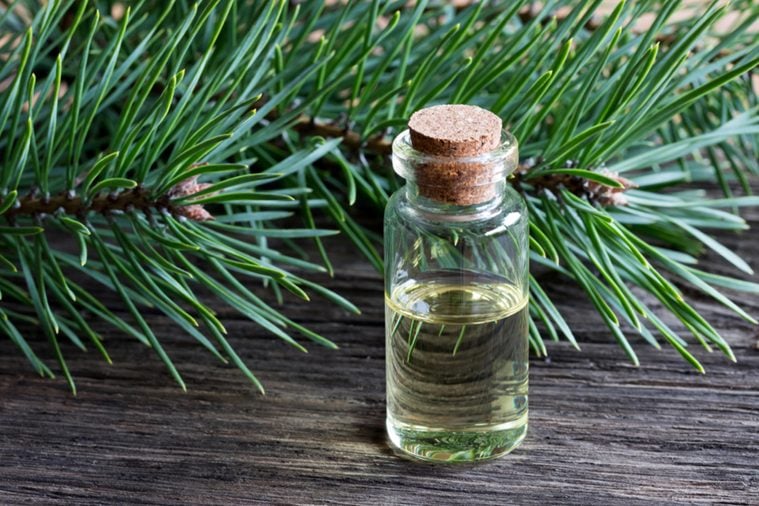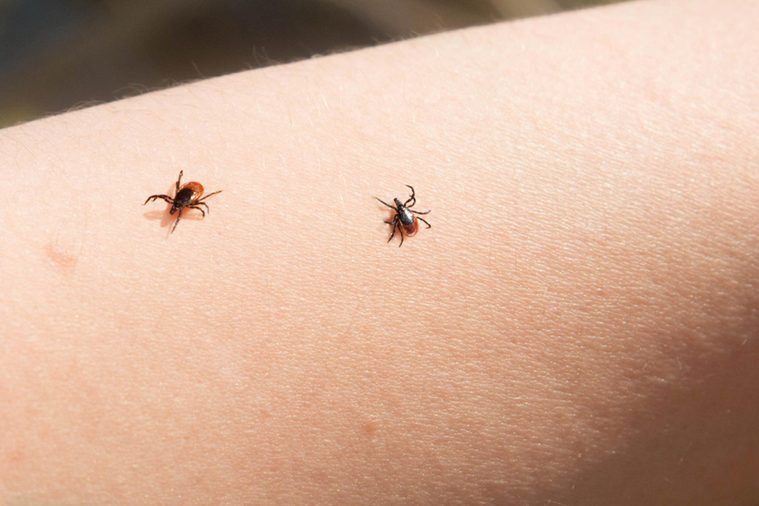
A well-groomed yard
One of the easiest ways to reduce ticks is to maintain your yard and its perimeter; about 82 percent of ticks found on lawns are discovered within nine feet of the lawn’s edge, especially if the lawn borders woods, stone walls, or lush leafy plantings or ground cover such as pachysandra. “Ticks don’t like dry and sunny conditions,” says Thomas Mather, director of the University of Rhode Island’s Center for Vector-borne Disease and the TickEncounter Resource Center. To minimize your exposure to ticks and their potential diseases, including Lyme disease, create a landscape that includes more sunny areas and a clearly defined border of wood chips or gravel between the lawn and the woods. Removing dead leaves and overgrown shrubs along the lawn’s perimeter can also help keep ticks away. Find out the 13 things ticks won’t tell you.

Plant strategically
Ticks hate certain plants, including lavender, feverfew, rosemary, marigolds, sage, and catnip, reports NaturalOn. Cultivate these plants in your yard, especially around the perimeter to naturally eliminate ticks from your yard. If left untreated, Lyme disease can cause a variety of symptoms from rash and fever to facial paralysis and arthritis. Other diseases such as Powassan are also on the rise and can cause symptoms from headache and vomiting to confusion, seizures, and memory loss. Check out the plants that repel mosquitoes naturally, too.

Cedar oil
An essential oil derived from conifer trees, cedar oil is a non-toxic, natural tick and insect repellent that can be sprayed on clothing or skin as well as plants. Research shows that the application of cedrol (the alcohol found in the essential oil) killed 100 percent of the black-legged nymphal ticks in the tested area. According to national pesticide producer Wondercide, cedar oil blocks the tick’s scent receptors, disrupts its body systems, and dries the bug up upon contact, disintegrating ticks in the nymphal stage. Ready to test it out? Try making a small dose of natural tick repellent in a spray bottle. Simply mix four ounces of distilled or boiled water, witch hazel, and 30 to 50 drops of cedar oil (along with other oils like lavender or vanilla for a sweet-smelling scent). Read about these new tick diseases—one of them is way worse than Lyme.

Guinea fowl
Originally from Africa, the colorful, odd-looking Guinea fowl, about the size of chickens only with more oval shaped bodies, love to eat ticks as well as other insects, small snakes, and rodents, such as deer mice, a primary carrier of the deer tick that carries Lyme Disease. One study has shown that guinea fowl reduced the numbers of adult deer ticks on lawns adjacent to dense foliage. The study also concluded that since adult deer ticks are likely to carry the Lyme disease bacterium, the presence of free-ranging guinea fowl may help reduce the probability of contracting Lyme Disease from adult ticks on lawns and lawn edges. While guinea fowl alone should not be relied on for total tick control, they are less expensive than having a lawn repeatedly treated for ticks. The birds require little maintenance, but they are noisy and territorial—your neighbors may not be fans.

Pyrethrin
Commonly used to treat lice and scabies, Permethrin is the synthetic, stronger version of Pyrethrin, a natural, organic compound that comes from an oil extracted from the chrysanthemum flower. Both compounds are proven tick and mosquito repellents, but Pyrethrin is the more environmentally friendly, safer alternative to Permethrin, although it does not last as long. Odorless and biodegradable, Permethrin is highly effective when sprayed on clothing (rather than your skin), with one application lasting up to four weeks (even with washing). One study showed that those who wore Permethrin-treated socks and sneakers were 73.6 times less likely to be bitten by ticks than those wearing untreated footwear. “The nymphal stage ticks, the ones that transmit most of the diseases, generally latch on at the shoe level,” explains Mather. Those still concerned about the product’s toxicity should note that Permethrin is 2,250 times more toxic to ticks than humans, and when applied to the skin, less than one percent of the active ingredient is absorbed into the body (DEET is absorbed at more than 20 times the rate). While Permethrin won’t harm humans or dogs, it is harmful to bees, fish, and aquatic insects.

Oil of lemon eucalyptus
Oil of lemon eucalyptus (OLE), which comes from the leaves of the Australian lemon-scented gum tree and its synthesized version, PMD (para-menthane-3,8-diol), are both approved by the EPA as effective tick repellents. Known by brand names such as Citrosynthol, Citrepel, and Citriodiol, these products are essential oils but are made when OLE is organically processed to increase its effectiveness. One study has shown that PMD is as effective as the chemical-based repellent DEET when used in similar quantities. “Oil of lemon eucalyptus smells nice and is natural, and it will provide protection for up to seven hours,” says Bobbi Pritt, MD, professor of laboratory medicine and pathology at the Mayo Clinic. “It’s comparable to DEET, which protects for up to eight hours, but DEET breaks down plastics, such as your watch band or electronics, while oil of lemon eucalyptus does not.” To find the best tick repellent for your needs, the EPA has a search tool that lets you select products based on criteria such as ingredient. If you do find a tick on you, here’s the only way you should remove it.

Tick tubes
Mice are carriers of the bacterium that causes Lyme disease and other tick-borne diseases, and one alternative to stopping the spread of the disease is to turn the hosts into tick killers. When placed around areas where mice live—stone walls, wood piles, along the foundation of your home, and grassy and wooded areas—mice enter the tubes, collect the Permethrin-treated cotton nesting material stashed inside, and bring it back to their nests. The Permethrin then binds to the oils on the fur of the mice, killing the ticks when they try to latch on. While the Permethrin does not harm the mice or the environment, it is toxic to fish and aquatic life. Tick tubes are one way to combat the number of ticks in your yard, but using them alone will not eradicate ticks completely. These are the most dangerous places in America for Lyme disease.

Garlic oil
Homeowners who prefer to avoid using chemicals on their lawn have turned to alternatives such as garlic oil, which one study showed helped to reduce the number of nymphal ticks. Companies such as Connecticut-based Greenskeeper offer a garlic oil application, diluted to a strength of 2.5 gallons of oil per 200 gallons of water when it is sprayed, as well as a solution that mixes garlic oil with cedar oil, another proven organic tick repellent. While garlic has been shown to repel ticks, it doesn’t kill them, and the garlic oil breaks down more quickly than synthetic treatments, meaning you will need more applications to keep ticks at bay.

Tick Control System (TCS)
It’s not just people, dogs, and cats that benefit from tick repellent; chipmunks and mice can use it too. But the trick, of course, is how to get it on them. That’s exactly what researchers at the Tick Project are working on. The Tick Control System (TCS), is a small box that attracts small mammals, such as mice and chipmunks, the rodents primarily responsible for infecting ticks with the Lyme bacterium. Upon entering the box, the animal receives a small dose of fipronil, the active ingredient in many tick treatments used on dogs and cats. While the treatment kills the ticks, it has no negative effects on people, pets, or the environment. Find out more foolproof tricks to avoid tick-borne illnesses.

Fungus
Naturally occurring in forest soils in eastern North America, Metarhizium anisopliae is a fungus that has been shown to be lethal to ticks. Researchers at Cary Institute of Ecosystem Studies are studying this fungus to see if it can be used to reduce ticks on a larger scale. Applied as a spray that’s made from the spores of the native entomopathogenic fungus (a fungus that acts as a parasite of insects and kills or disables them), known as Met52, commercially, it has been shown to kill ticks, and according to the EPA, it is not harmful to humans or the environment. Researchers at Cary Institute of Ecosystem Studies have found that the fungus is effective when it’s delivered to the nesting materials inside mice nests. Stay tuned for further developments. Read on for the 10 things to do right now if you’re bitten by a tick.
